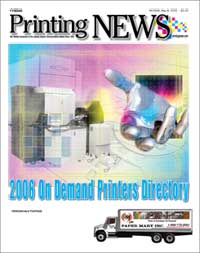|
  May 8, 2006—The hospitality industry is booming, with hotels and casinos growing and becoming more and more elaborate. In places like Las Vegas, they compete with each other for the flashiest, most awe-inspiring motifs, but what good is a casino if no one comes to stay? That is where graphic communications comes in, and where a print shop can become an invaluable partner. May 8, 2006—The hospitality industry is booming, with hotels and casinos growing and becoming more and more elaborate. In places like Las Vegas, they compete with each other for the flashiest, most awe-inspiring motifs, but what good is a casino if no one comes to stay? That is where graphic communications comes in, and where a print shop can become an invaluable partner.
There is a large variety of work a resourceful shop can become involved in, and not just print. According to Jere Ames-Johnson, president, Graphics West, Las Vegas, the key is to go in and sell solutions. Casinos, especially, are very database-driven, he notes, and they want to send follow-up offers to clients based on how long they stayed, what games they played, and how much they spent. A casino wants the ability to do full personalization, tieing an offer in to each guest's individual interests.
Obviously, some organizations utilize their database to a greater degree than others. However, Mr. Ames-Johnson notes that all of them are looking at it as an option, and he predicts that this segment of the industry will only continue to grow.
Make no mistake though, while digital technology plays a major role in the transformation of the graphics industry, it is not completely supplanting traditional offset. In fact, Graphics West only acquired its digital machines, a variety of Xerox equipment including the iGen3, recently. The firm also has a full range of offset machines, as well as a bindery and finishing department with advanced abilities such as die-cutting and foil stamping.
Mr. Ames-Johnson notes that having these abilities plays a big part in how the shop stays successful, despite growing competition across the globe. No matter what is called for—from full variable pieces, to premiums with a host of offers enticing guests to return to the hotel, to static shells with variable added later, to a full static job?they can do it all.
The types of work casinos and hotels require cover a broad range of items. Mr. Ames-Johnson places them in two categories: in-room items and direct-mail pieces.
In-room jobs include hotel directories, menus, and flyers. Direct mail includes all of the pieces hotels send out, from brochures to custom invitations. In the increasingly competitive hospitality industry, hotels are seeking new ways to cut through clutter and bring in customers.
Ann Balch, purchasing manager for Mohegan Sun in Uncasville, Conn., notes that two of its more unusual promotions included a talking invitation sent out to promote a New Year's Eve event, as well as a fur-covered invitation alerting guests to a new animatronic wolves exhibit.
Print shops have an opportunity to approach these establishments and work with them to find innovative ways to reach customers—they are ready and willing to hear your ideas.
However, cautions Mr. Ames-Johnson, you cannot go in with print samples and expect to be successful. He notes that shops interested in capturing a piece of this market have to go in with an attitude of becoming a marketing partner, not a printer.
Quality, he notes, is a given today with the increase in affordable technology. Shops that do their homework and learn not only about the business, but about an individual hotel's theme and issues, will find that this can be a very lucrative niche market. Mr. Ames-Johnson notes that it is a very fast-paced market where turn-around times can be quick, but his own shop sees 80 percent of its work come from this type of job. It not only can be done, it can be profitable, too.
In the Cards
Another possible entry into the gaming industry is through marketing and manufacturing playing cards. The bulk of this type of work is done by large companies specializing in nothing but cards. The opportunity to market variable and/or promotional cards, though, is a potentially huge and as-yet not much explored niche.
Entry into this area is now feasible for a realatively small investment, with equipment such as the Rollem Revolution making it easy for shops to start offering this as part of an overall marketing plan.
The Revolution begins with a full printed sheet, cuts the sheet in two directions—vertically and horizontally—collects the imaged cards into a single collated pack, then automatically die cuts the pack into final shape and size. From there, it can integrate all packaging processes including boxing and wrapping as one automated system capable of producing up to 2,400 packs per hour with one operator. In addition, the same machine can be used to produce postcards, greeting cards, and business cards, giving a shop even more options with a single investment.
?Historically if you wanted to have your company logo printed on the back of a pack of cards, you would need to order a high volume of packs because the large offset format is benefitted by higher volume runs," explains Larry Corwin, president, Rollem USA, Anaheim, Calif. "Now with digital imaging or variable data so easily accomplished on a digital press, it would seem like orders of six, 12, or 24 packs of cards will become very easy to run and very profitable to sell—up to 500 percent profit per pack."
The opportunities in hospitality printing are out there and waiting for ambitious shops to take advange of them. This is another example of how a niche market can bring huge success in a fracturing industry. It is no longer just about the print?it is about the total package, and in some cases, the roll of the dice.
|


